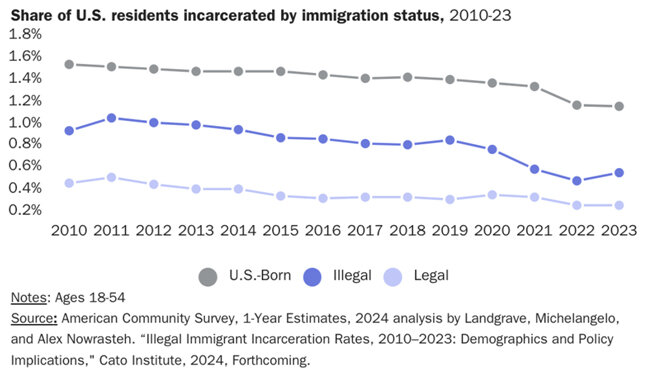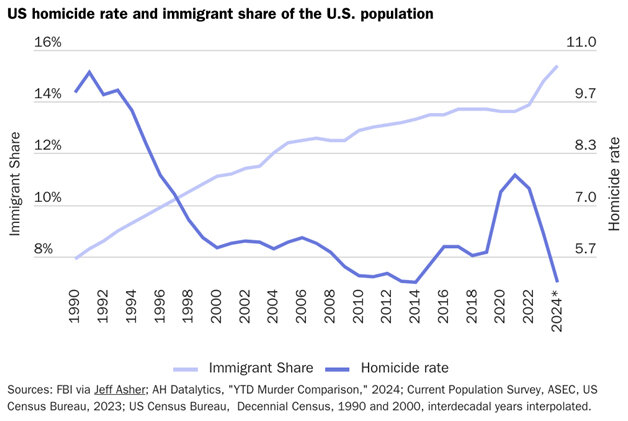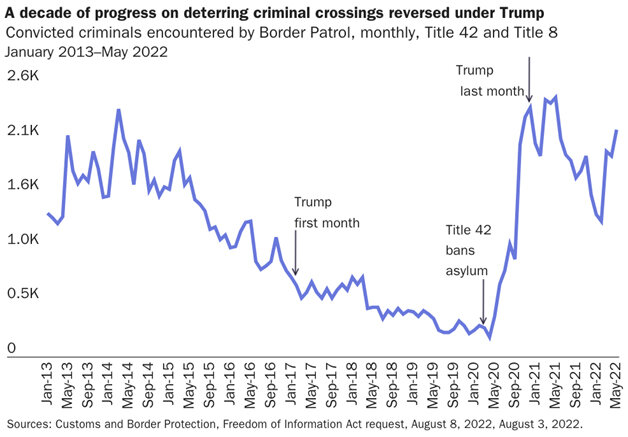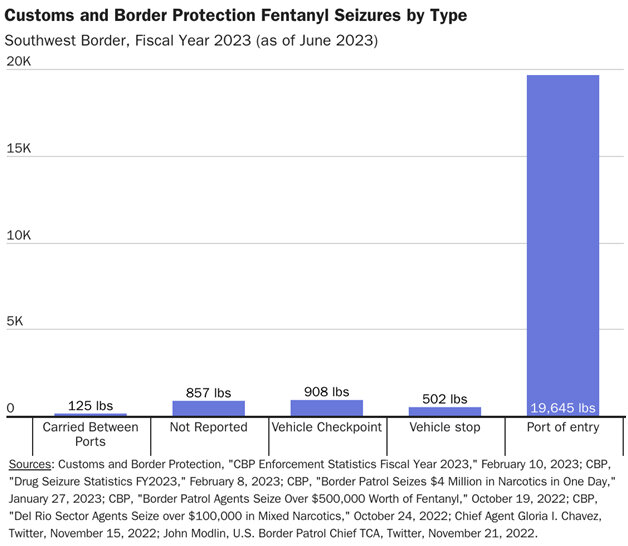1 Much of this testimony revises my past testimony on these issues.
2 Jonathan Blitzer, “The Immigrants Most Vulnerable to Trump’s Mass Deportation Plans Entered the Country Legally,” The New Yorker, December 5, 2024.
3 David J. Bier, “Biden’s New Immigrants: Employment, Education, Jobs, and Industries,” Cato at Liberty (blog), November 14, 2024.
4 Congressional Budget Office, “Effects of the Immigration Surge on the Federal Budget and the Economy,” CBO, July 2024.
5 David J. Bier, “Biden’s New Immigrants: Employment, Education, Jobs, and Industries,” Cato at Liberty (blog), November 14, 2024.
6 “Gunfire: Line of Duty Deaths,” Officer Down Memorial Page, accessed December 6, 2024.
7 New York City Police Department, “NYPD Memorials: Fallen Heroes,” accessed December 6, 2024.
8 “GSS 1972–2021 Cumulative Datafile,” UC Berkeley Survey Documentation and Analysis (SDA), 2024.
9 U.S. Census Bureau, “Introduction to American Community Survey Group Quarters Data,” Census Academy Webinar, September 20, 2022.
10 Hoan N. Bui, “Parent-Child Conflicts, School Troubles, and Differences in Delinquency Across Immigration Generation,” Crime & Delinquency 55, no. 3 (2008): 412–441.
Xi Chen, and Hua Zhong, “Delinquency and Crime among Immigrant Youth—An Integrative Review of Theoretical Explanations,” Laws 2, no. 3 (2013): 210–232.
Kathleen Mullan Harris, “Chapter 6: The Health Status And Risk Behaviors Of Adolescents In Immigrant Families, ”National Research Council (US) and Institute of Medicine (US) Committee on the Health and Adjustment of Immigrant Children and Families; Hernandez DJ, editor. Washington (DC): 1999.
11 Alex Nowrasteh, “USCIS Report Shows that DACA Arrest Rate Is Below that of Other U.S. Residents,” Cato at Liberty (blog),June 19, 2018.
12 Robert Brame et al., “Cumulative Prevalence of Arrest From Ages 8 to 23 in a National Sample,” Pediatrics 129, no. 1 (2012): 21–27.
Joe Craven McGinty, “How Many Americans Have a Police Record? Probably More Than You Think,” Wall Street Journal, August 7, 2015.
13 Alexander F. Roehrkasse and Christopher Wildeman, “Lifetime risk of imprisonment in the United States remains high and starkly unequal,” Science Advances 8, no. 48 (2022).
14 Michael G. Vaughn et al., “The immigrant paradox: immigrants are less antisocial than native-born Americans,” Social Psychiatry and Psychiatric Epidemiology 49, no. 7 (2014): 1129–37.
15 Min Xie and Eric P. Baumer, “Reassessing the Breadth of the Protective Benefit of Immigrant Neighborhoods: A Multilevel Analysis of Violence Risk by Race, Ethnicity, and Labor Market Stratification,” January 1, 2018.
Graham C. Ousey and Charis E. Kubrin, “Exploring the connection between immigration and violent crime rates in U.S. cities, 1980–2000,” Social Problems 56, no. 3 (2009): 447–473.
16 Walter Morris, “Teen arrested in killing of ride-share driver who served as interpreter for US in Afghanistan,” NBC4 Washington, March 1, 2024.
17 Tim Wadsworth, “Is Immigration Responsible for the Crime Drop? An Assessment of the Influence of Immigration on Changes in Violent Crime Between 1990 and 2000.” Social Science Quarterly 91, no. 2 (2010): 531–53;
Jacob I. Stowell et al., Immigration and The Recent Violent Crime Drop in The United States: A Pooled, Cross-Sectional Time-Series Analysis of Metropolitan Areas. Criminology 47, no. 3 (2009): 889–928.
18 “New York Crime Rates 1960 – 2019,” Disastercenter.com, 2020.
19 Tim Wadsworth, “Is Immigration Responsible for the Crime Drop? An Assessment of the Influence of Immigration on Changes in Violent Crime Between 1990 and 2000.” Social Science Quarterly 91, no. 2 (2010): 531–53;
Jacob I. Stowell et al., Immigration and The Recent Violent Crime Drop in The United States: A Pooled, Cross-Sectional Time-Series Analysis of Metropolitan Areas. Criminology 47, no. 3 (2009): 889–928;
R.J. Sampson, “Rethinking Crime and Immigration.” Contexts 7, no. 1 (2008): 28–33;
Garth Davies and Jeffrey Fagan, “Crime and Enforcement in Immigrant Neighborhoods: Evidence from New York City,” The ANNALS of the American Academy of Political and Social Science 641, no. 1 (2012): 99–124;
Matthew T. Lee, Ramiro Martinez, Jr., and Richard Rosenfeld, “Does Immigration Increase Homicide? Negative Evidence from Three Border Cities.” The Sociological Quarterly 42, no. 4 (2001): 559–80;
Lesley Williams Reed et al., “The immigration–crime relationship: Evidence across US metropolitan areas,” Social Science Research 34, no. 4 (2005): 757–780;
Ben Feldmeyer et al., “More immigrants, less death: An analysis of immigration effects on county-level drug overdose deaths, 2000–2015,” Criminology 60, no. 4 (2022): 667–699;
Ben Feldmeyer, “Immigration and violence: the offsetting effects of immigrant concentration on Latino violence,” Social Science Research 33, no. 3 (2009): 717–31;
Michael T. Light and Ty Miller, “Does Undocumented Immigration Increase Violent Crime?” Criminology 56, no. 2 (2018): 370–401;
Graham C. Ousey and Charis E. Kubrin, “Exploring the connection between immigration and violent crime rates in U.S. cities, 1980–2000,” Social Problems 56, no. 3 (2009): 447–473;
Min Xie and Eric P. Baumer, “Reassessing the Breadth of the Protective Benefit of Immigrant Neighborhoods: A Multilevel Analysis of Violence Risk by Race, Ethnicity, and Labor Market Stratification,” January 1, 2018;
Ramiro Martinez, Jr., et al. “Immigration and Crime in an Era of Transformation: A Longitudinal Analysis of Homicides in San Diego Neighborhoods, 1980–2000” Criminology 48, no. 3 (2010): 797–830.
20 Ben Feldmeyer et al., “More immigrants, less death: An analysis of immigration effects on county-level drug overdose deaths, 2000–2015,” Criminology 60, no. 4 (2022): 667–699.
21 “YTD Murder Comparison Dashboard,” AH Datalytics, 2024.
22 W Spelman, “Abandoned Buildings: Magnets for Crime?,” Journal of Criminal Justice 21, no. 5 (1993): 481- 495.
23 Pages 17–22: Immigration and Metropolitan Revitalization in the United States. United States: University of Pennsylvania Press, Incorporated, 2017.
24 Jacob L. Vigdor, “Immigration, Housing Markets, and Community Vitality,” Cato Institute, 2017.
25 Emma Sapong, “Bangladeshis transforming Buffalo, one block at a time,” The Buffalo News, December 12, 2015.
26 See pp. 17–22: Immigration and Metropolitan Revitalization in the United States. United States: University of Pennsylvania Press, Incorporated, 2017.
27 Pierre Azoulay et al., “Immigration and Entrepreneurship in the United States,” American Economic Review: Insights 4, no. 1 (2022): 71–88.
28 “Bringing Vitality to Main Street: How Immigrant Small Businesses Help Local Economics Grow,” Fiscal Policy Institute, Americas Society/Council of the Americas, January 2015.
29 Josh T. Smith, “When Immigrants Are and Aren’t Afraid of Reporting Crime,” The Center for Growth and Opportunity at Utah State University, November 8, 2021.
30 Alex Nowrasteh and Andrew C. Forrester, “Immigrants Recognize American Greatness: Immigrants and Their Descendants Are Patriotic and Trust America’s Governing Institutions,” Cato Institute Immigration Research and Policy Brief no. 10, February 4, 2019.
31 “Witness in New York Police Killings Passes Lie Detector Test, Leaves Town,” AP News, September 1989.
32 Tobias Salinger, “Hero grad student describes catching Stanford rapist:, ” New York Daily News, April 8, 2018.
33 Stuart Anderson, “The Immigrant Who Died Defending A Crime Victim,” Forbes, December 17, 2018.
34 “Feidin Santana, Who Recorded Police Shooting of Walter Scott, Speaks Out,” NBC News, April 8, 2015.
35 Charles Rabin and David Ovalle, “Man who saved Miami officer: ‘How could I not?’” Miami Herald, April 15, 2015.
36 Zinnia Maldonado and Jesse Zanger, “Video shows good Samaritans holding Queens subway stabbing suspect down,” CBS News New York, July 29, 2024.
37 David Bier, “Donald Trump Is Wrong—Immigrants Don’t Commit More Crimes,” Time, September 27, 2016.
38 Jeri Clausing, “Man who saved girl says he’s illegal immigrant,” NBC News, August 19, 2011.
39 There is an annual cap of 10,000 U visas.
40 “Number of Service-wide Forms Fiscal Year To Date,” USCIS, 2023.
41 “Office of Immigrant Affairs,” Nassau County Distrtict Attorney’s Office, 2024.
42 Zahra Hankir, “Immigrants are reviving Paterson, N.J., from its difficult past,” Los Angeles Times, September 26, 2019.
43 “Microdata Access Tool (MDAT),” Census Bureau, February 2023.
44 John M. MacDonald, Jonathan Klick, and Ben Grunwald, “The Effect of Private Police on Crime: Evidence from a Geographic Regression Discontinuity Design,” Journal of the Royal Statistical Society Series A: Statistics in Society 179, no. 3 (2016): 831–846.
45 Daphne Duret and Weihua Li, “It’s Not Just a Police Problem, Americans Are Opting Out of Government Jobs,” The Marshall Project, January 21, 2023.
46 Simone Weichselbaum, “Desperate for Recruits, Police Consider Non-Citizens,” The Marshall Project, February 14, 2019.
47 These figures come from an updated version of this paper: Alex Nowrasteh, Sara Eckhardt, and Michael Howard, “The Fiscal Impact of Immigration in the United States,” Cato Institute White Paper, March 21, 2023.
48 Elisa Jácome, “The effect of immigration enforcement on crime reporting: Evidence from Dallas,” Journal of Urban Economics 128 (2022).
49 Liz Robbins and Nadia T. Rodriguez, “The Gang Murders in the Long Island Suburbs,” New York Times, July 12, 2017.
50 Brigitte Stelzer and Steven Vago, “Mom of 5‑Year-Old Girl Raped by Illegal Migrant in NY ‘Losing Confidence in the World,’” New York Post, November 1, 2024.
51 Elisa Jácome, “The effect of immigration enforcement on crime reporting: Evidence from Dallas,” Journal of Urban Economics 128 (2022).
52 The New York City Council, “A Local Law to amend the administrative code of the city of New York, in relation to immigration enforcement,” Legislative Research Center, December 1, 2017.
53 Department of Homeland Security (DHS), “Secretary Mayorkas Delivers Remarks at the U.S. Conference of Mayors,” DHS Newsroom. January 20, 2022;
Adam Shaw, “White House Calls for Sanctuary Cities to Cooperate with ICE Amid Furor over Illegal Immigrant Crimes,” Fox News, February 28, 2024.
54 Colleen Johnson, “ICE and Baltimore County Agree to Policy Adjustments,” Fox Baltimore, June 5, 2024.
U.S. Immigration and Customs Enforcement (ICE), “ERO Baltimore Reaches Landmark Agreement with Montgomery County on Immigration Detainers,” March 1, 2024.
55 Paul Liotta, “NYC Mayor Adams Calls for Change to Sanctuary City Laws,” New York City Council. July 9, 2024.
56 Maria Sacchetti, “Immigration Arrests of Noncriminals Double Under Trump” Washington Post, April 16, 2017.
57 David J. Bier, “New Data on Trump’s Border Security Record: Releasing Criminals to Jail Asylum Seekers,” Cato at Liberty (blog), October 30, 2024.
58 “Deportation; Sanctions; Surfmen | 60 Minutes Full Episodes,” 60 Minutes, Youtube video, October 30, 2024.
59 “‘Zero Tolerance’ at the Border: Rhetoric vs. Reality,” TRAC Immigration, July 24, 2018.
60 Ms. L. v. U.S Immigration & Customs Enforcement, 310 F. Supp. 3d 1133 (S.D. Cal. 2018).
61 “Review of the Department of Justice’s Planning and Implementation of Its Zero Tolerance Policy and Its Coordination with the Departments of Homeland Security and Health and Human Services,” Department of Justice Office of the Inspector General, revised April 13, 2022.
62 P. 67.
63 “DHS Lacked Technology Needed to Successfully Account for Separated Migrant Families,” DHS Office of the Inspector General, November 25, 2019.
64 “Special Review — Initial Observations Regarding Family Separation Issues Under the Zero Tolerance Policy,” DHS Office of the Inspector General, September 27, 2018.
65 “DHS Lacked Technology Needed to Successfully Account for Separated Migrant Families,” DHS Office of the Inspector General, November 25, 2019.
66 David J. Bier, “New Data on Trump’s Border Security Record: Releasing Criminals to Jail Asylum Seekers,” Cato at Liberty (blog), October 30, 2024.
67 David J. Bier, “New Data on Trump’s Border Security Record: Releasing Criminals to Jail Asylum Seekers,” Cato at Liberty (blog), October 30, 2024.
68 Sean F. Altekruse et al., “Socioeconomic risk factors for fatal opioid overdoses in the United States: Findings from the Mortality Disparities in American Communities Study (MDAC),” PLoS ONE 15, no. 1 (2020).
69 Ben Feldmeyer et al., “More immigrants, less death: An analysis of immigration effects on county-level drug overdose deaths, 2000–2015,” Criminology 60, no. 4 (2022): 667–699.
70 David J. Bier, “U.S. Citizens Were 89% of Convicted Fentanyl Traffickers in 2022,” Cato at Liberty (blog), August 23, 2023.
71 CBP, “Drug Seizure Statistics FY2023,” February 2023.
72 Department of Homeland Security, “Department of Homeland Security Border Security Metrics Report: 2021,” April 2022.
73 Department of Homeland Security, “Department of Homeland Security Border Security Metrics Report: 2021,” April 2022.
74 Customs and Border Protection, “CBP Enforcement Statistics Fiscal Year 2023,” February 10, 2023;
CBP, “Drug Seizure Statistics FY2023,” February 8, 2023;
CBP, “Border Patrol Seizes $4 Million in Narcotics in One Day,” January 27, 2023;
CBP, “Border Patrol Agents Seize Over $500,000 Worth of Fentanyl,” October 19, 2022;
CBP, “Del Rio Agents,” October 24, 2022;
Chief Agent Gloria L. Chavez, Twitter, November 15, 2022;
John Modlin, U.S. Border Patrol Chief TCA, Twitter, November 21, 2022.
75 CBP, “Drug Seizure Statistics FY2023,” February 8, 2023.
76 “2020 National Drug Threat Assessment,” US DOJ Drug Enforcement Administration, March 2021.
77 Foreign Relations Committee, “Countering Illicit Fentanyl Trafficking,” February 2023.
78 Senate Homeland Security and Governmental Affairs Committee, Subcommittee on Government Operations and Border Management, “Federal Government Perspective: Improving Security, Trade, and Travel Flows at the Southwest Border Ports of Entry,” November 17, 2021.
79 Salvador Rivera, “Murders pile up as cartels battle for control of Tijuana’s drug-trafficking corridor,” Border Report, August 22, 2022.
80 United States Senate Committee on Homeland Security and Governmental Affairs, “Securing America’s Ports Act,” September 9, 2020.
81 “The White House will work to add 123 new large-scale scanners at border crossings by September 2026. This would increase the number of scanned personal vehicles from just 2 percent to 40 percent, while expanding the number of cargo vehicles from 17 percent to 70 percent, CBP said.”
Paul Ingram, “In Nogales, White House official touts vehicle scanners to combat fentanyl smuggling,” Tucson Sentinel, July 3, 2023.
Angelina Hicks and Alex Riggins, “Border Patrol seizes $3.7M-worth of fentanyl hidden in truck near Campo,” San Diego Tribune, July 20,2022.
21 “Marijuana smuggling into the United States has occurred at consistently high levels over the past 10 years, primarily across the US–Mexico border”. See p. 19, Drug Enforcement Administration, “2013 National Drug Threat Assessment Summary,” November 2013.
83 See p. 12, Drug Enforcement Administration, “2013 National Drug Threat Assessment Summary,” November 2013.
84 Sarah G Mars, Jeff Ondocsin, and Daniel Ciccarone, “Sold as Heroin: Perceptions and Use of an Evolving Drug in Baltimore, MD,” Journal of Psychoactive Drugs 50, no. 2 (2017): 167–176.
85 Allison Roberts, Jessica Korona-Bailey, Sutapa Mukopadhyay, “Notes from the Field: Nitazene-Related Deaths –Tennessee, 2019–2021,” MMWR Morbidity and Mortal Weekly Report 71 (2022): 1196–1197.
86 David J. Bier, “Green Card Approval Rate Reaches Record Lows,” Cato Institute Briefing Paper no. 173, February 15, 2024.
















